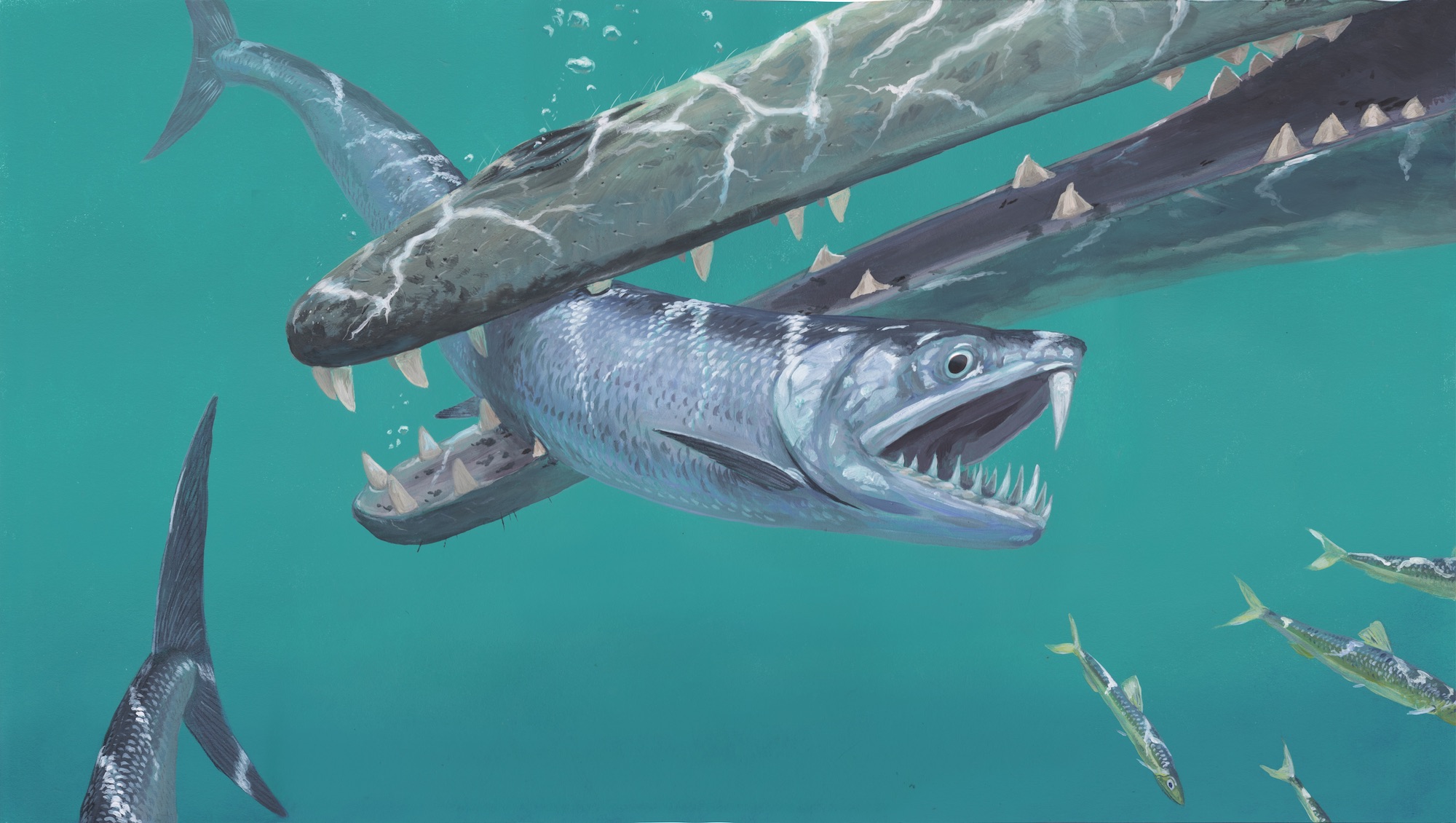Ancient 'shapeshifting vampire demon' anchovy had saber tooth and fangs

Scientists have discovered the remains of two ancient fish that sported fanged teeth on their lower jaws and a huge, single saber tooth on the top.
These now-extinct fish are so weird, there's no other known fish — living or dead — that look like them.
The fishes' teeth are so strange that scientists named one of them Monosmilus chureloides, which roughly translates to "single knife Churel." If you're wondering what a Churel is, don't read this before bedtime; it's a shapeshifting vampire-like demon with large fangs found in the folklore of several South Asian countries, including Pakistan, where the fossil was unearthed.
Related: My, what sharp teeth! 12 living and extinct saber-toothed animals
The two ancient fish, however, have two very different origin stories. One was found in Belgium and described in 1946 by paleontologist Edgar Casier, who named it Clupeopsis straeleni. This 11-inch-long (27.8 centimeters) fish lived during the early Eocene epoch, about 50 million years ago.
In contrast, the newly described 3-foot-long (1 meter) M. chureloides lived about 45 million years ago in the shallow seas of what is now Pakistan. It lived at the same time and place as some of the earliest four-legged whales, including Dalanistes. This fish had 16 fang-like curved teeth on its lower jaw that were small in the back and "progressively larger towards the front," said study lead researcher Alessio Capobianco, a doctoral student in the Department of Earth and Environmental Sciences at the University of Michigan.
The longest fang was 0.8 inches (2 cm), or about 20% the length of the whole head. Like a shark, this fish probably shed and replaced its teeth periodically, "as we found some replacement teeth in development on the lower jaw," Capobianco said.
Get the world’s most fascinating discoveries delivered straight to your inbox.
On the upper jaw is a giant curved fang that Capobianco jokingly calls the "saber tooth."
"When the mouth was closed, it would have extended from the top of the mouth all the way down to the bottom of its 'chin,'" he said. M. chureloides probably used its extraordinary teeth to hunt smaller fishes. "However, it is difficult to hypothesize their exact purpose, as no fish today has a similar set of teeth," Capobianco said. "It could be that the long teeth formed a sort of 'trap' or 'cage' for the prey, similar to what happens in some deep-sea fishes, or they could have been used to stab other fishes."
But these are just guesses. "It's all in the realm of speculation," Capobianco said. "We simply do not know at the moment."
The single M. chureloides specimen was collected in 1977 by a joint expedition from the University of Michigan and the Geological Survey of Pakistan. But only recently was it examined, when Capobianco and his advisor, the study's senior researcher Matt Friedman, an associate professor of paleontology and director at the Museum of Paleontology at the University of Michigan, took a look at it.
After a CT scan revealed the specimen's fearsome teeth, Friedman recalled a similar, wacky saber tooth in the C. straeleni fossil. So, the team compared the two specimens.
Related: Image gallery: 25 amazing ancient beasts
"Clupeopsis and Monosmilus are clearly closely related because there is no other known fish (living or extinct) that has the same complement of teeth: a row of large fang-like teeth on the lower jaw, no teeth on the margin of the upper jaw and a single giant 'saber-tooth' on the top of the mouth," Capobianco said. "There is simply no other fish that looks like this."
An anatomical analysis revealed that these saber-toothed fishes are closely related to anchovies. "That was another big surprise for us, as all living anchovies are much smaller than those extinct forms," Capobianco said. "And most [anchovies] are specialized to eat plankton and have very tiny teeth."
Perhaps, it's not so strange that these two fish enjoyed a mini-heyday during the early Eocene. The nonavian dinosaurs went extinct about 65 million years ago, when a giant asteroid hit Earth at the end of the Cretaceous period. That mass extinction decimated not just creatures on land but also in the seas. But the oceans didn't stay empty for long.
"Most of the kinds of fishes that you can observe in the sea nowadays originated during this critical period of time," Capobianco said. "Alongside those, bizarre 'evolutionary experiments' like the saber-toothed anchovies also evolved and diversified, but for some reason they didn't make it to the modern day. "
The study was published online today (May 13) in the journal Royal Society Open Science.
- Moonfish: The first warm-blooded fish (photos)
- Oarfish: Photos of world's longest bony fish
- In photos: 'Faceless' fish rediscovered after more than a century
Originally published on Live Science.
OFFER: Save 45% on 'How It Works' 'All About Space' and 'All About History'!
For a limited time, you can take out a digital subscription to any of our best-selling science magazines for just $2.38 per month, or 45% off the standard price for the first three months.

Laura is the managing editor at Live Science. She also runs the archaeology section and the Life's Little Mysteries series. Her work has appeared in The New York Times, Scholastic, Popular Science and Spectrum, a site on autism research. She has won multiple awards from the Society of Professional Journalists and the Washington Newspaper Publishers Association for her reporting at a weekly newspaper near Seattle. Laura holds a bachelor's degree in English literature and psychology from Washington University in St. Louis and a master's degree in science writing from NYU.



